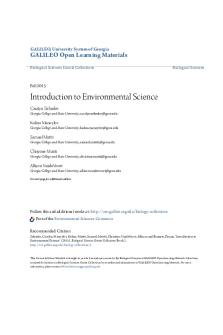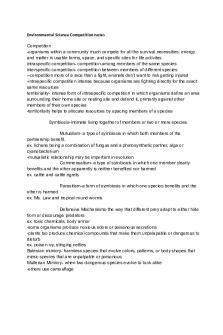Chapter 4 of Environmental Science Notes PDF

| Title | Chapter 4 of Environmental Science Notes |
|---|---|
| Author | Paige Lassiter |
| Course | Introduction to Environmental Sciences |
| Institution | Louisiana State University |
| Pages | 5 |
| File Size | 241.2 KB |
| File Type | |
| Total Downloads | 4 |
| Total Views | 152 |
Summary
These notes highlight some of the topics discussed in lecture #4 in the introduction to environmental science course....
Description
Characteristics of exponential growth: Doubling time is constant Population versus time is j shaped Exponential Growth: Rate of change= rN Logistic growth: Rate of change= rN (1-n/k) r- and K- selected population (r strategist and k strategist) R-selected species tend to always be in the exponential growth phase. J- curve= exponential growth S- curve- logistic growth
Rate adults are producing offspring are called biotic potential. Biotic potential→ recruitment
Adults→ Offspring→ Adults R-strategist have high biotic potential but poor recruitment most of the time. K-strategist have low biotic potential but good recruitment. Environmental resistance: combination of biotic and abiotic factors that limit the increase of a population. Density-dependent limiting factors are needed to regulate a population Example- food shortage
Density-independent factors can be very important but are not associated with regulation Example- forest fires Critical number: population size below which recovery is unlikely. Example: cheetah About 10,000 years ago, almost all of them were wiped out. Low genetic diversity made reproduction and recruitment of cheetahs difficult. Only about 5% of offspring survive to become adults.
R- tend to fluctuate K- tend to be stable What limited the size Density- dependent limits help to maintain equilibrium
Wolves eating moose represent density dependent relationships. Wolves and moose on Isle Royale. Why do wolves never eat all the moose? An adult moose in healthy shape are not a target for wolves, wolves go for younger or older moose. Interactions do not always lead to stable populations. Reindeer introduced to St. Matthew island- there now aren’t predators. Example of the interaction: water buffalo and bird. Commensalism- where somebody benefits. Perturbations that can lead to unstable populations Concept of keystone species-sea otters like to eat urchins, the sea urchins like to eat kelp. If you remove the sea otters, the whole kelp first falls apart Keystone species: A species whose role is essential for the survival of many other species in an ecosystem. Competition: Intraspecific competition Territorality Dense-dependent regulation of population. Interspecific competition Competitive exclusion Natural selection- survival of the fittest Diversity of species explained by the fact that environment are heterogeneous in space and time.
Resource Partitioning Division of a resource and specialization in different parts of it Character displacement A physical change that lessens competition when two species co-occur
Resource partitioning by 5 species of warblers in the spruce forest of Maine. (it means they limit their resources and not to overstep territories or food interest) Consequences of change (biotic or abiotic) Three things to do: adaptation, migration, or extinction Polar bears (Urus maritimus) are brown bears that adapted to their climate. California Condor species is down, humans take them in to make the species flourish, When released, 42 of the birds died and 50% had lead to toxicity. Acclimation (change in phenotype) Example- getting along with your roomate Adaptation (change in genotype) Evolution- natural selection Example- Mosquitos become resistant to DDT after it being sprayed sound a lot.
Position of continents impacts climate How does continental drift affect climate? Movement to different latitudes (Antartica to South Pole) Alteration of ocean currents (closing of Isthmus of Panama, opening of Drake passage) Creation of mountain ranges (Himalayas) Causes of the current Ice Age Himalaya Mountains Drake passage Separation of Australia from Antarctica
Closing of Isthmus of Panama
Implications of adaptation for human management - Invasive species and pets Example kuduz, rats, and cats...
Similar Free PDFs

Environmental Science Lecture notes
- 25 Pages

Environmental Science
- 16 Pages

Environmental Science Module 1
- 4 Pages

Environmental Science and Engineering
- 109 Pages

Environmental Science Midterm Review
- 17 Pages

Environmental Science Questions
- 52 Pages

Environmental Science Review Sheet
- 19 Pages
Popular Institutions
- Tinajero National High School - Annex
- Politeknik Caltex Riau
- Yokohama City University
- SGT University
- University of Al-Qadisiyah
- Divine Word College of Vigan
- Techniek College Rotterdam
- Universidade de Santiago
- Universiti Teknologi MARA Cawangan Johor Kampus Pasir Gudang
- Poltekkes Kemenkes Yogyakarta
- Baguio City National High School
- Colegio san marcos
- preparatoria uno
- Centro de Bachillerato Tecnológico Industrial y de Servicios No. 107
- Dalian Maritime University
- Quang Trung Secondary School
- Colegio Tecnológico en Informática
- Corporación Regional de Educación Superior
- Grupo CEDVA
- Dar Al Uloom University
- Centro de Estudios Preuniversitarios de la Universidad Nacional de Ingeniería
- 上智大学
- Aakash International School, Nuna Majara
- San Felipe Neri Catholic School
- Kang Chiao International School - New Taipei City
- Misamis Occidental National High School
- Institución Educativa Escuela Normal Juan Ladrilleros
- Kolehiyo ng Pantukan
- Batanes State College
- Instituto Continental
- Sekolah Menengah Kejuruan Kesehatan Kaltara (Tarakan)
- Colegio de La Inmaculada Concepcion - Cebu








